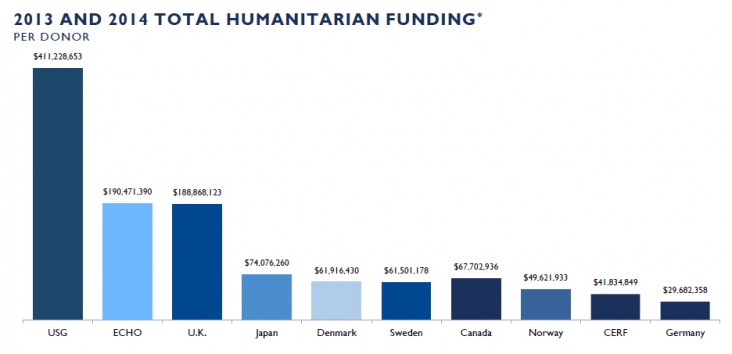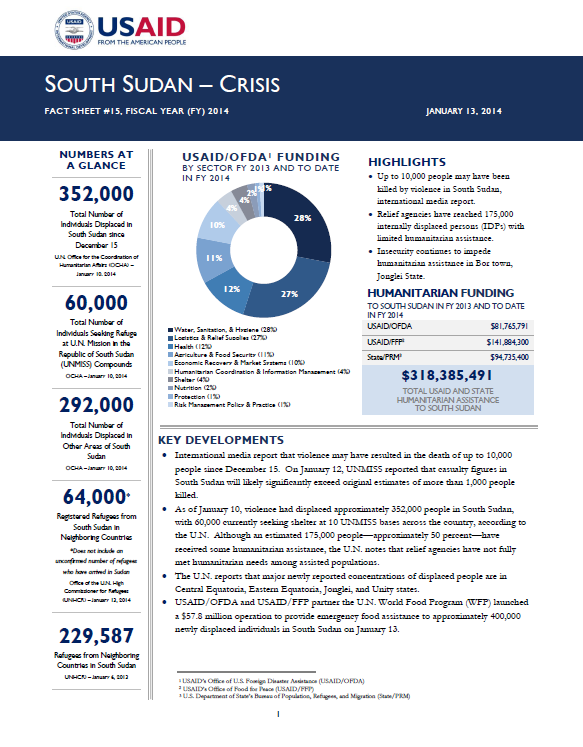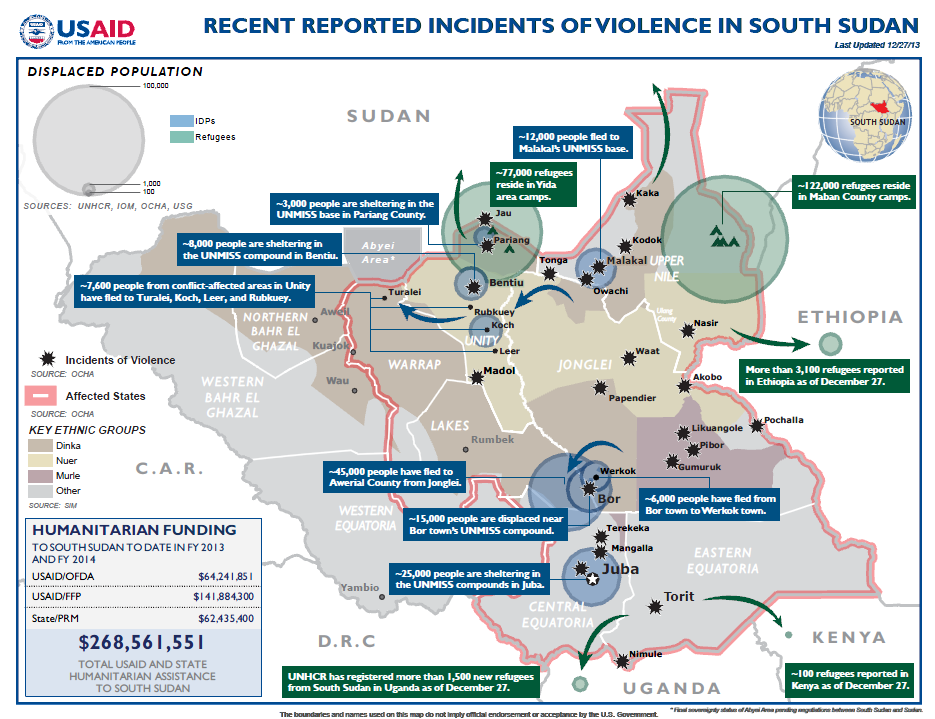- What We Do
- Agriculture and Food Security
- Democracy, Human Rights and Governance
- Economic Growth and Trade
- Education
- Environment and Global Climate Change
- Gender Equality and Women's Empowerment
- Global Health
- Humanitarian Assistance
- Transformation at USAID
- Water and Sanitation
- Working in Crises and Conflict
- U.S. Global Development Lab
Speeches Shim
February 11, 2014
Numbers At A Glance
723,900
74,800
649,100
145,000
231,600
Humanitarian Funding:
To South Sudan To Date In FY2013 and FY2014:
| USAID/OFDA | $87,156,812 |
| USAID/FFP | $141,884,300 |
| State/PRMDoD | $94,735,400 |
| TOTAL | $323,776,512 |
Highlights
Security conditions and population movements remain unpredictable in conflict-affected areas.
Emergency food assistance reaches more than 227,000 people.
Measles vaccination campaigns result in decreasing mortality rates at UNMISS bases in Juba, Central Equatoria State.
KEY DEVELOPMENTS
Clashes continue in areas of Lakes and Unity states, and population movements remain fluid across South Sudan, with nearly 724,000 South Sudanese internally displaced and an additional 145,000 people seeking refuge in neighboring countries. Although estimates of internally displaced persons (IDPs) have decreased since early February due to population returns to Bor town, Jonglei State, and Malakal town, Upper Nile State, the U.N. notes that tens of thousands of people are moving throughout the country, making displacement verification and population tracking difficult.
The humanitarian community reiterates that unfettered access is essential to enable relief activities for all conflict-affected populations throughout Government of the Republic of South Sudan (RSS)-held and opposition-controlled areas of South Sudan. Although relief agencies have reached approximately 302,500 people with assistance despite severe access constraints, persistent access impediments could worsen humanitarian conditions.
While relief agencies remain concerned regarding health conditions among overcrowded IDP populations at the UNMISS Tong Ping base in Juba, the U.N. reports that overall health conditions have improved and morality rates are now below emergency levels.
Negotiations on the cessation of hostilities agreement between RSS authorities and opposition group representatives—previously scheduled to resume in Addis Ababa, Ethiopia, on February 10—were postponed, according to international media.
SITUATION, DISPLACEMENT, AND HUMANITARIAN NEEDS UPDATE
Insecurity continues to affect communities and impede humanitarian access in Lakes and Unity states, while security conditions remain relatively stable in other areas of South Sudan. Ongoing fighting has particularly hampered emergency response activities in Unity, where violence has displaced approximately 190,300 people. Aid operations continue to face logistical challenges in other remote areas, particularly in Jonglei, where access to opposition-held areas remains challenging, and in Upper Nile, where insecurity and the presence of armed groups has impeded the transportation of fuel and other essential supplies from southern areas.
Relief agencies continue to monitor food insecurity across South Sudan, while ongoing fighting and limited humanitarian access will likely result in deteriorating food security conditions among an estimated 3.2 million people requiring humanitarian aid, according to the U.N. If violence continues, inconsistent humanitarian access will likely result in Crisis—Integrated Food Security Phase Classification (IPC) 3—levels of food insecurity among conflict-affected populations through March, according to the USAID-funded Famine Early Warning Systems Network (FEWS NET).[1] In areas experiencing heavy fighting, people with no access to humanitarian assistance may face Emergency—IPC 4—levels of food insecurity.
Although large-scale measles vaccination campaigns have resulted in decreasing measles cases and associated improvements in mortality rates at the Tong Ping IDP site in Juba, relief agencies remain concerned by unstable health conditions among IDPs across South Sudan. Despite improved living conditions at the UNMISS base in Bor, mortality rates remain elevated—but below emergency levels—in part due to measles cases. Many conflict-affected areas remain at high risk of disease outbreaks due to increased population displacement, overcrowding, inadequate availability of safe drinking water, poor sanitation conditions, limited access to health care services, and food shortages, according to the Health Cluster—the coordinating body for humanitarian health activities, comprising U.N. agencies, non-governmental organizations (NGOs), and other stakeholders. Health agencies have recorded nearly 550 suspected measles cases and more than 80 measles-related deaths across IDP areas—including UNMISS civilian protection sites and other IDP settlements—since hostilities began on December 15.
South Sudan Crisis Fact Sheet #26 February 11, 2014 ![]() (pdf - 376k)
(pdf - 376k)
South Sudan Crisis Map #26 February 11, 2014 ![]() (pdf - 956k)
(pdf - 956k)
HUMANITARIAN RESPONSE ACTIVITIES
Although humanitarian organizations have reached approximately 302,500 people with humanitarian assistance since hostilities erupted on December 15, relief agencies have not fully met needs among assisted populations due to a lack of sustained, predictable access, according to the U.N. Among those assisted, more than 227,100 individuals have benefited from emergency food rations and nearly 211,600 people have received water, sanitation, and hygiene (WASH) assistance. In addition, humanitarian agencies have reached nearly 42,000 families with critical shelter and relief commodity support.
To facilitate the provision of humanitarian assistance, the Camp Coordination and Camp Management Cluster established three humanitarian hubs—one in Mingkaman town, Awerial County, Lakes State, and two in Juba—to provide crucial office and accommodation space for humanitarian staff. An additional hub at the UNMISS base in Bor will become operational in the coming days, according to the U.N.
In response to persistent concerns related to the protection of civilians, relief agencies specializing in protection are consulting with UNMISS and other humanitarian actors on voluntary, safe, and dignified solutions for IDPs in UNMISS bases, as well as addressing needs among the wider population of individuals displaced or affected by ongoing conflict. To ensure the protection of civilians throughout emergency response activities, the Protection Cluster has trained more than 50 NGO staff on managing child-friendly spaces, improving psychosocial well-being, promoting child protection, and maximizing protection from sexual and gender-based violence in emergency WASH facilities.
USAID/OFDA partners continue to provide life-saving assistance through the USAID/OFDA-funded, International Organization for Migration (IOM)-managed Rapid Response Fund (RRF) in conflict-affected areas across South Sudan. Since December 15, USAID/OFDA has awarded more than $2.6 million through the RRF, which allows USAID/OFDA to quickly route funding to international and national NGOs working on the ground in South Sudan to provide assistance to vulnerable groups, including IDPs in UNMISS bases and those displaced in rural areas.
Central Equatoria
Significant challenges remain as humanitarian actors continue efforts to decongest the two UNMISS sites in Juba, Tong Ping and U.N. House 3, where more than 44,000 IDPs are located. IDPs in Tong Ping and U.N. House 3 reportedly remain reluctant to return to their neighborhoods in Juba, fearing SPLA reprisal attacks. The humanitarian community continues to consider responsible, secure, and voluntary solutions to the issue of overcrowding at UNMISS bases.
Since February 3, humanitarian organizations have distributed household items to more than 6,000 families in Tong Ping.
Save the Children/U.S. (SC/US) is conducting protection activities for IDPs in Juba with a portion of nearly $552,000 in RRF support. To date, SC/US has provided protection assistance to nearly 130 separated and unaccompanied children in the two UNMISS compounds in Juba—Tong Ping and U.N. House 3. SC/US is also conducting family tracing and reunification activities, reuniting nearly 50 children with family members in Juba since hostilities began.
Relief agencies conducted rapid needs assessments in Central Equatoria’s Bungu, Ganzi, Lainya, and Yei towns, identifying concentrations of displaced populations and associated humanitarian needs among IDPs and host communities in each location. Humanitarian actors are exploring response options and are prioritizing potential activities, such as the provision of basic services, food assistance, and protection support.
Jonglei
Humanitarian actors are working to improve WASH conditions at the UNMISS base in Bor, increasing the provision of safe drinking water to 13 liters per person per day—nearly reaching international standards of 15 liters per person per day—and access to latrines to one latrine per 40 people—surpassing the global emergency response standard of 50 people per latrine. To reduce public health risks, relief agencies continue to prioritize robust WASH activities, such as the construction of bathing shelters and hygiene promotion activities.
As the security situation remains calm but tense in Bor, IDPs sheltering in the UNMISS compound are reportedly expressing a willingness to return to areas of origin, the U.N. reports. The hospital in Bor has recently re-opened and is treating some patients—most with trauma-related wounds. RSS authorities are attempting to convince hospital staff to return to work; however, limited food availability in Bor and the absence of a functioning market continue to hinder staff from returning, according to International Medical Corps.
Lakes
Relief agencies continue to provide humanitarian assistance—including access to safe drinking water, health care services, protection support, and WASH activities—to more than 84,000 people in Awerial, the largest IDP site in South Sudan. Humanitarian actors are registering additional populations for assistance, noting that fluid population movements in the area continue to pose challenges for accurate registration activities.
Humanitarian organizations are mobilizing efforts to verify unconfirmed reports of approximately 3,000 people newly displaced in Yirol East and Yirol West counties.
Unity
Ongoing fighting in Unity, particularly in Guit, Leer, and Mayom counties, continues to hinder humanitarian access and prevent emergency assistance from reaching conflict-affected populations in the area. Relief agencies continue to receive reports of major population displacement and abuses against civilians by armed actors but remain unable to confirm these reports due to insecurity. Interagency teams recently assessed humanitarian conditions in Mayom County, finding Mayom town largely destroyed and deserted.
The security situation at the UNMISS base in Bentiu town, Unity, has improved in recent weeks following the deployment of U.N. police to the area, according to UNMISS. Additional police personnel has reportedly enabled UNMISS to increase security patrols and improve communication with IDPs sheltering in the UNMISS civilian protection site.
With more than $305,000 in RRF funding, Mercy Corps continues to provide WASH assistance to IDPs in Bentiu. To date, Mercy Corps has installed emergency latrines in the protection of civilians section of the Bentiu UNMISS base, planned the construction of four emergency showers, organized the collection and disposal of solid waste, and improved hygiene education at the UNMISS site. Due to the reduced caseload in the UNMISS base, Mercy Corps and the WASH Cluster plan to expand humanitarian assistance projects to other conflict-affected areas of Unity, including Abiemnom, Koch, Leer, Mayendit, Mayom, and Panyijiar counties, when security conditions allow.
Upper Nile
Improved security conditions in Malakal town, Upper Nile, have enabled relief agencies to resume and expand aid operations at the local UNMISS base, as well as approximately eight additional displacement sites in the town. U.N. agencies are facilitating the delivery of relief items—such as blankets, mosquito nets, plastic sheeting, sleeping mats, and water containers—to up to 10,000 people during the week of February 10. While relief agencies are providing adequate access to safe drinking water for IDPs inside the UNMISS base, overcrowding continues to result in additional sanitation challenges.
To respond to urgent food needs in Malakal, USAID/FFP partner the U.N. World Food Program (WFP) had airlifted approximately 75 metric tons (MT) of food commodities—sufficient to provide a full ration for approximately 4,500 people for one month—to Malakal for distribution at the UNMISS base as of February 6. WFP is also assessing humanitarian conditions in areas outside of the UNMISS compound as security permits.
OTHER HUMANITARIAN ASSISTANCE
To address increased humanitarian needs, the U.N. released a revised South Sudan Crisis Response Plan on February 3, identifying $1.27 billion in humanitarian funding needs. The $1.27 billion requirement includes $741 million to secure all core pipelines for the remainder of the year and $443 million for front-line services through June. Of the funding requested in the revised plan, more than 50 percent would support the Food Security and Livelihoods Cluster to address emergency food needs. To date, international donors have provided approximately $246 million[2] to support humanitarian activities through the South Sudan Crisis Response Plan.

*Funding figures are as of February 11, 2014. All international figures are according to OCHA’s Financial Tracking Service (FTS) and based on international commitments during the 2013 and 2014 calendar years. USG figures are according to the USG and reflect the most recent USG commitments based on the 2013 fiscal year, which began on October 1, 2012, and ended September 30, 2013, as well as the 2014 fiscal year, which began on October 1, 2013.



Comment
Make a general inquiry or suggest an improvement.